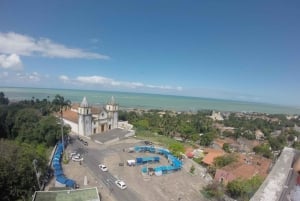The Sertão (Drylands)
The Sertão or Drylands of North-East Brazil have been depicted in films and books due to the arid beauty of its nature and interesting set of characters which populate its history: bandits, sugarcane barons and Saints. Though notably less hospitable than the areas closer to the coast, a few cities in the Sertão have grown over time into popular destinations.
This prosperous city stands by the shores of the São Francisco river. Though at the far western tip of Pernambuco, it is simple getting there in less than an hour thanks to the regular flights leaving from Recife. Other ways of exploring the Sertão are the intercity buses, from Recife, or, if you are particularly adventurous, hiring a car (though the distances and poor communications coverage can be a problem).
Petrolina has something unique to offer which you won't find elsewhere in Pernambuco (or nearby in Brazil for that matter): wine tourism. By means of irrigation, local producers have made better usage of the waters from the São Francisco river, successfully growing tropical fruits, among which, grapes and mangoes. Wine production here is curious as we are only 9°S, in a semi-arid region and through irrigation, up to 2.5 crops can be harvested per year. Tours include visiting the vineyards and wine tasting. Nonetheless, as this tradition is still deepening its roots in the area, wine tourism is still not as developed as in France, Italy, Argentina or Chile. Click here to see what companies offer this type of experience.
The city has an interesting typical dish to harmonize with its tropical wine: goat. This animal is quintessential in the diet of the Sertão, and at the "Bodódromo" you can taste all the many ways in which it is served and soak up the atmosphere among the locals. Petrolina is also known for its handicrafts, especially "as Carrancas", scary figureheads made in wood or clay, that according to Ana das Carrancas, the woman that created them, are to scare away the bad spirits that may disturb the fishmen on The São Francisco River. You can visit the "Centro de Cultura Ana das Carrancas", where you can appreciate her work.
The São Francisco river offers many options to visitors. It is possible to take ferries to visit the river islands (some of which have river beaches you can lay down and enjoy), or just to take a walk under the setting sun along the river banks, all duly paved with a boardwalk.
If you wish to know what lies on the other side of the river, take the bridge and you'll get to Juazeiro, Petrolina's sister city in the neighbour State of Bahia. From it is possible to reach some interesting destinations: a waterfall and a cave with stalactite formation, though they are rather distant from the town (50 and 100km).
Declared a Cultural Heritage of Humanity by Unesco in 1991, the Serra da Capivara is a large, hilly geological formation in neighbour State Piauí. The quickest way to access it is from Petrolina, which is 300 km away from the national park.
This park stretches for nearly 130 thousand ha and conceals many features which make it a gem of the drylands. Most importantly, it has archaeological sites displaying cave paintings and other traces of human presence dating back to 100 thousand years (a date which puzzles the mainstream theories of how the continent was first populated). There are literally hundreds of galleries covered in primitive drawings, the earliest lore of man in the Americas. The "Museu do Homem Americano" will help you make sense of it all, showing some of the tools, bones and other artifacts found on site.
Visitors will also be awestruck by the endemic vegetation and wildlife, typical of the Caatinga biome, and by the majestic landscape. The most famous geological formation is the Pedra Furada, a large cliff with a whole in the middle. Against the blue sky, it seems like an eye looking over Creation, which spotted the first homo sapiens of the land hundreds of thousands of years ago.
The Park is watched over by a larger than life figure, Dr. Niede Guidon, a French-born archaelogist, who has fought for the funding and protection of its treasures for decades. This has brought her both praise from international institutions and the scientific community and criticism from those who do not view ancient history as a solution for the deep poverty of the region. Surely the development of a local and international sustainable tourism demand is an excellent way to improve everyone's life and preserve Capivara's natural and man-made attractions. One result of this struggle has been the construction of a runway and its terminal building will hopefully be completed in 2013, and ready to receive passengers from Brazil and further afield.
Access to Triunfo is not very simple: at least a four-hour drive from Recife, or taking one of the buses that leave the capital daily. In spite of that, more and more people are visiting this "oasis in the dryland" for its festivities, traditional gastronomy and its cooler microclimate.
The Guarany Theatre is the city's postcard, with its well preserved 19th century architecture. The site is still used today as a cinema and theatre. In recent years, a national competitive film festival has been held in the location around August.
Triunfo receives the largest number of visitors during winter, when the "Festival do Estudante" is held. Prestigious singers and musicians share the stage with dance and theatre performances. Carnival is also a main event, when the streets get taken over by a curious figure, the "Caretas": masked dancers who take a whip in hand and crack it as they go. Sounds kind of rough? Welcome to the Sertão.
Also, this town can be educational about two important elements in Pernambuco's history. The first is "Lampião", the most notorious bandit of Pernambuco's outback - who was actually quite fond of this city. By visiting the "Museu do Cangaço" you can see objects of his time and learn more about other outlaws of the "cangaço" era. The second important one is the "engenhos", the sugar mills that commanded the sugarcane business that dominated Pernambuco's economy. Around Triunfo there are different "engenhos" you can visit and see the artisanal production of cachaça and "rapadura", a typical candy.
Triunfo's ecotourism has one of the best options in the State: waterfalls, caves and viewing points from where you can have a striking view of the surroundings (Pico do Papagaio, Mirante Belverde and Cruzeiro do Alto da Boa Vista). If you came from the capital by car, chances are it is potent enough to get you to those sites.
Arid places, as it seems, have long exerted some attraction for those in search of being closer to God. Serrita (530km from Recife), is a far away and difficult to get to town, and yet it holds a yearly event which can gather thousands of people: the Missa do Vaqueiro (the Herdsman or Cowboys' Mass).
This event started over 50 years ago with the unsolved murder of a respected herdsman. In his honour, a mass was held, and every year it grew bigger, thanks also to its support by priests, poets and musicians (being one of them Luiz Gonzaga, who sang of this dryland martyrdom on his famous song "A Morte do Vaqueiro").
Since 1971, the Missa do Vaqueiro has been held every year, on the third Sunday of July. A large cortege with cowboys from all around the Sertão rides from Serrita to the park where the mass is held, 32 km away from the city. The ceremony is today a homage to the "vaqueiro" character, his fortitude and lifestyle, with several chants sung to the cadence of their own typical tunes. The scene of hundreds of riders on their horses, singing a mass under the clear sky of the Sertão, is quite powerful. So much so, it has been the scenery for international films and TV documentaries.
During the preceding week, the "Festa do Vaqueiro" is held in town, which is a great opportunity to see authentic displays of the "vaqueiro" culture. You can see several groups playing forró, xaxado, baião and other rhythms, and also the "repentistas", troubadours which duel one another for making the fastest, wittiest rimes.
This affluent city of the Sertão is bound to become one of the most important and wealthy ones in the region in years to come with the construction of a logistical hub for the Transnordestina railway, one of the biggest federal enterprises in the region.
Presently, Salgueiro (510km from Recife) is best known for its popular culture, pre-historic sites nearby, handcraft and, last but not least, its soccer team. Serra das Letras, Pedra da Mão, Pedra das Abelhas and Sítio Paula are some of the sites close to Salgueiro that can be seen and where visitors can find cave paintings from pre-historic eras.
On the more modern side of history, you'll find on Salgueiro's streets 17th century churches and, most importantly, timeless displays of a vibrant culture, such as the Dança do Trancelim, Mestre Jaime's Frevo and the Festival da Sanfona in April, a show for both famous and hidden talents of the accordion.
Be sure to visit the Memorial do Couro (Leather Memorial), where an exhibit tells in great detail the relationship between this material (widely used in handicraft from the region) and the Sertão.
* Photos by Evaldo Parreira, Wikimedia Commons and Eudes Santana (EMPETUR).

















